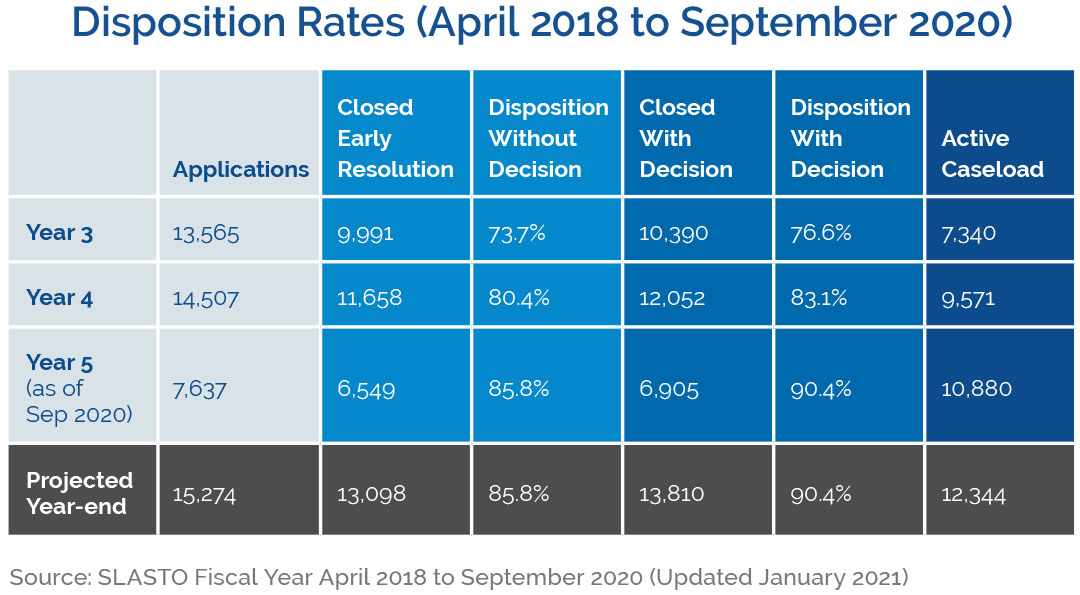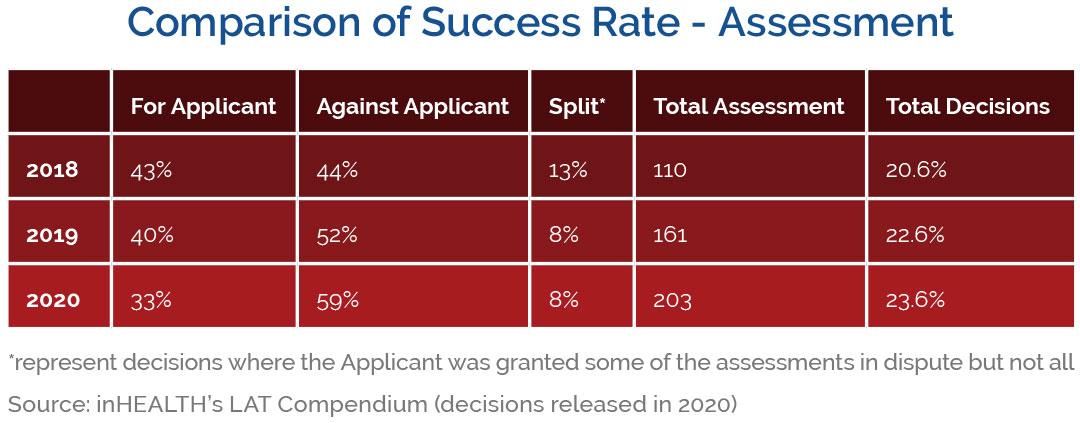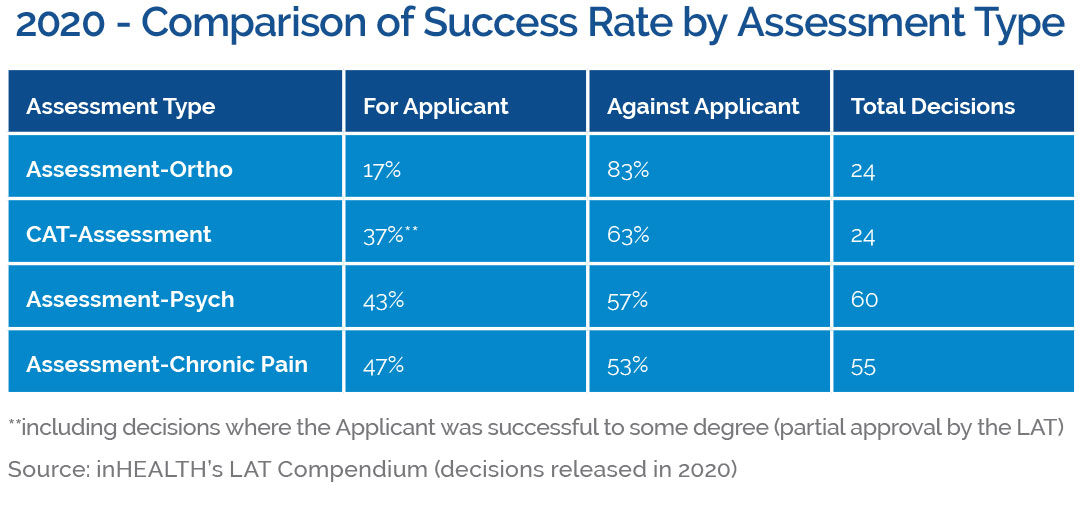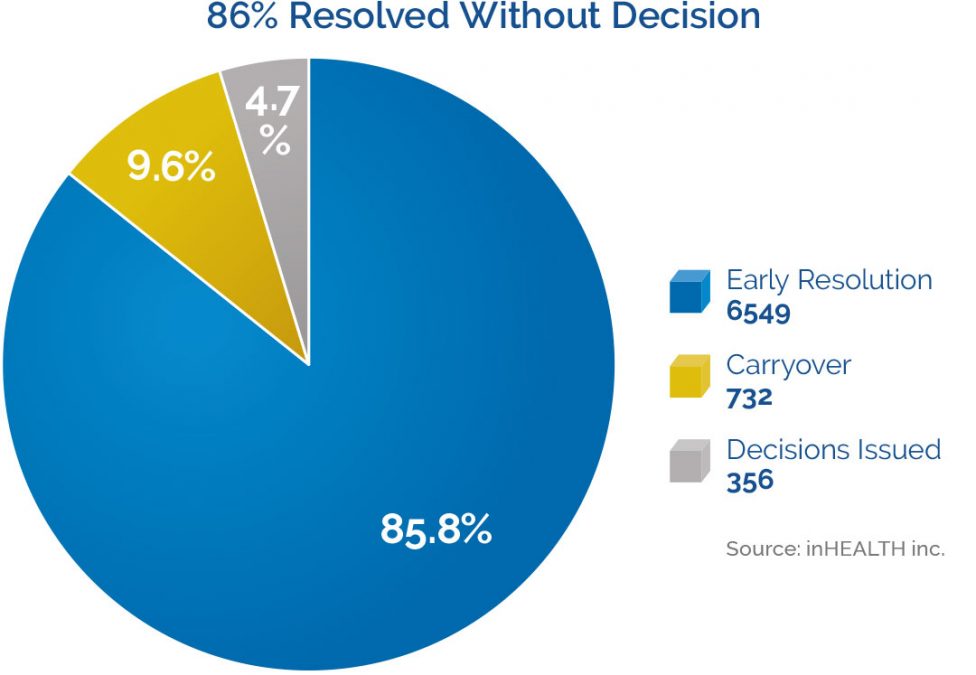Not much has truly changed in the almost 5 years the LAT has been hearing AB disputes. However, one number stands out – the rate of resolution without a decision.
The files closed within the LAT without a decision is trending in year 5 to-date at 86%. This represents files with very little involvement of LAT resources. Do these truly need to be funneled through the LAT process?

The recently published year 5 LAT stats (up to Sep 2020) reveal a considerable push to bring matters to decision. The Tribunal published 356 hearing decisions in the first half of year 5 which is the average in each of the previous 3 years. This may simply represent a clearing of the considerable backlog, as in the first half of year 5 actual hearings held decreased by 48% as compared to prior year.

Impact on Disposition Rate
If year 5 continues on pace, the Tribunal will reach a 90.4% disposition rate, still short of reducing the ever growing caseload. In years 3 and 4, the disposition rates were 76.6% and 83.1% respectively. While improvements continue, they are still not enough on their own to stem the tide.
With applications on pace for a 5.3% increase, the active caseload, despite positive gains, will increase by 13.5%.
Tribunal’s Strategies to Increase Efficiency & Productivity
The Tribunal goes to great lengths in explaining the various options available and recommended approaches, all with the goal of avoiding the need to file applications.¹
This excerpt from the Tribunals Ontario’s Annual Report released at the end of Year 4 (Mar 2020), reporting on their operational highlights:
“The LAT continues to promote and facilitate the early resolution of all disputes between the parties. The LAT has introduced several streamlined approaches to the service delivery of decisions, case conference orders and reports. These improvements in a key business service area will provide increased capacity for timely issuance of adjudicative decisions. An expedited procedure to deal with motions and preliminary issues was introduced in the third quarter with the expectation that it would lead to an earlier resolution of disputes.”²
Settled Law
With the Tribunal’s strategies in mind, we do see issues such as MIG determination, IRB and NEB entitlement to be reasonably well understood now in terms of what is required to succeed. Certainly though, a number of files involving these issues were justified in proceeding based upon certain distinguishing factors.
However, the volume of such cases in 2020 strongly suggests an overrepresentation of such files receiving, likely though not requiring adjudication via the LAT.

Entitlement to IRB is an area where the requirements seem fairly well established. In 2020, the Applicants were successful in continuing entitlement and post 104 entitlement in 25% of the cases. In matters involving initial entitlement, success rate was but 10%.
While the number of applications continues to outpace the resolution activity, it bears repeating that the volume of applications could in part be driven by the inconsistency of decisions. The uncertainty of outcomes naturally drives more disputes.
Far from Settled
Globally, assessments in general continue as a main driver of the Tribunal’s volume, not at all surprising given the historical success rates.

Assessments as a whole are trending against the Applicant after 2018. In 2020 the gap is further widened, with a drop to 33% for the Applicant. This divergence can be attributed to the decrease in the Applicant’s success rate on CAT and orthopaedic assessment as shown below.
Other examples where LAT jurisprudence seems far from settled are CAT determinations where the success/failure rate over the past two years is approximately 50/50. Similarly, assessments involving psychological or chronic pain also hover within the same range.

Stakeholders
There have been suggestions of implementing a form of “simplified procedure” to “fast-track” a subset of claims to an expedited written hearing.
On the surface, it is hard to fathom how encouraging even more matters to proceed to decision, in an already overwhelmed institution, will do much to assist what plagues the system. In fact, it could exacerbate the situation further, both with sheer volume/capacity and consistency in decision making.
Another proposal was that there be a “45 day window” upon filing of a LAT application to allow the parties to attempt an “informal resolution”. This of course is similar to the suggestion of Justice Cunningham for the insurers to establish an internal review process. That, however, was intended to be at the time of denial, in order to potentially limit the number of disputes that even get to the LAT.
Time for Change
With the LAT the only game in town, tweaking their internal processes absent a mandated gatekeeping function, we are really no further ahead. This would need to be in conjunction with incorporating a robust internal review/pre-step into the operational procedures of the insurers. Together this would reduce the 86% of disputes resolved within the LAT without a decision. Otherwise, the LAT will continue to deal with far too many matters that they will never ultimately adjudicate.
We cannot afford to wait any longer before making changes to a beleaguered dispute system.
¹AABS: Before Filing an AABS Application (https://tribunalsontario.ca/lat/automobile-accident-benefits-service/before-filing-an-aabs-application/)
²Tribunals Ontario 2019-20 Annual Report (https://tribunalsontario.ca/documents/TO/Tribunals_Ontario_2019-2020_Annual_Report_EN.pdf)





